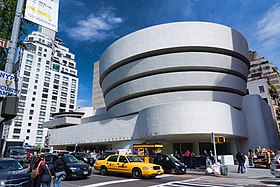
Back متحف سولومون غاغينهايم Arabic متحف سولومون جاجينهايم ARZ Muséu Solomon R. Guggenheim AST Solomon Quqqenhaym muzeyi Azerbaijani Соломон Гуггенхайм музейы Bashkir Музей Саламона Гугенхайма Byelorussian Музей Соломон Гугенхайм Bulgarian সলোমন আর গুগেনহাইম মিউজিয়াম Bengali/Bangla Museu Guggenheim (Nova York) Catalan Guggenheimovo muzeum Czech
 View from Fifth Avenue | |
 | |
| Established | 1937 |
|---|---|
| Location | 1071 Fifth Avenue at 89th Street Manhattan, New York City |
| Coordinates | 40°46′59″N 73°57′32″W / 40.78306°N 73.95889°W |
| Type | Art museum |
| Visitors | 861,000 (2023)[1] |
| Director | Richard Armstrong |
| Public transit access | Subway: Bus: M1, M2, M3, M4, M86 SBS |
| Website | www |
| Built | 1956–1959 |
| Architect | Frank Lloyd Wright |
| Architectural style(s) | Modern |
| Criteria | Cultural: (ii) |
| Designated | 2019 (43rd session) |
| Part of | The 20th-Century Architecture of Frank Lloyd Wright |
| Reference no. | 1496-008 |
| Region | Europe and North America |
| Designated | May 19, 2005[2] |
| Reference no. | 05000443[2] |
| Designated | October 6, 2008[3] |
| Designated | March 25, 2005[4] |
| Reference no. | 06101.008546[4] |
| Designated | August 14, 1990[5][6] |
| Reference no. | 1774 (exterior), 1775 (interior) |
The Solomon R. Guggenheim Museum, often referred to as The Guggenheim, is an art museum at 1071 Fifth Avenue between 88th and 89th Streets on the Upper East Side of Manhattan in New York City. It hosts a permanent collection of Impressionist, Post-Impressionist, early Modern, and contemporary art and also features special exhibitions throughout the year. It was established by the Solomon R. Guggenheim Foundation in 1939 as the Museum of Non-Objective Painting, under the guidance of its first director, Hilla von Rebay. The museum adopted its current name in 1952, three years after the death of its founder Solomon R. Guggenheim. It continues to be operated and owned by the Solomon R. Guggenheim Foundation.
The museum's building, a landmark work of 20th-century architecture designed by Frank Lloyd Wright, drew controversy for the unusual shape of its display spaces and took 15 years to design and build; it was completed in 1959. It consists of a six-story, bowl-shaped main gallery to the south, a four-story "monitor" to the north, and a ten-story annex to the northeast. A six-story helical ramp extends along the main gallery's perimeter, under a central ceiling skylight. The Thannhauser Collection is housed within the top three stories of the monitor, and there are additional galleries in the annex and a learning center in the basement. The museum building's design was controversial when it was completed but was widely praised afterward. The building underwent extensive renovations from 1990 to 1992, when the annex was built, and it was renovated again from 2005 to 2008.
The museum's collection has grown over the decades and is founded upon several important private collections, including those of Guggenheim, Karl Nierendorf, Katherine Sophie Dreier, Justin Thannhauser, Rebay, Giuseppe Panza, Robert Mapplethorpe, and the Bohen Foundation. The collection, which includes around 8,000 works as of 2022[update], is shared with sister museums in Bilbao, Spain, and Venice, Italy. In 2023, nearly 861,000 people visited the museum.[1]
- ^ a b Angeleti, Gabriella (March 26, 2024). "US museums blame falling visitor numbers for staff redundancies". The Art Newspaper - International art news and events. Retrieved April 19, 2024.
- ^ a b "National Register Information System". National Register of Historic Places. National Park Service. March 13, 2009.
- ^ Cite error: The named reference
NHLwas invoked but never defined (see the help page). - ^ a b "Cultural Resource Information System (CRIS)". New York State Office of Parks, Recreation and Historic Preservation. November 7, 2014. Retrieved July 20, 2023.
- ^ "The Solomon R. Guggenheim Museum" (PDF). New York City Landmarks Preservation Commission. August 14, 1990. Retrieved June 18, 2019.
- ^ "The Solomon R. Guggenheim Museum: Interior" (PDF). New York City Landmarks Preservation Commission. August 14, 1990. Retrieved June 18, 2019.
© MMXXIII Rich X Search. We shall prevail. All rights reserved. Rich X Search